COVID-19 and Public Health: Analysis of Opinions in Social Media
Abstract
1. Introduction
2. Materials and Methods
2.1. Materials
- Data collection period: 2 June 2021 to 16 July 2021.
- Number of messages: 176,334
- Number of actors: 103,018.
- Engagement: 712,560.
- Audience: 581,905,792.
2.2. Methods
2.3. Procedures
2.3.1. Digital Content Analysis
2.3.2. Offline Sociological Survey
3. Results
3.1. Key Topics
- 1.
- Mandatory vaccination for students (8879):Students have to get vaccinated before the start of the academic year, preferably before July 1, Minister of Health said.Yeah, and they said it was voluntary… Schoolkids, you’re next!Users’ reactions:“You’ve got to be really dumb to think it’s going to be voluntary :)VOLUNTARY, oh yeah babyWell, it is, but if you’re not vaccinated you can’t go anywhere or do anything”
- 2.
- Routine medical care for vaccinated only (4276):Routine medical care in Moscow will be provided only to vaccinated citizens (ria.ru)Users’ reactions:“*gasp*At least they’re not killing us… yetWell, you can relax for now, it says there that emergency aid’s going to be provided to unvaccinated, too”
- 3.
- Discrimination against unvaccinated people (3875):Peskov made a comment about the discrimination of unvaccinated people:“The reality is that such discrimination is unavoidable…”And in a few hours all hell broke loose.Sobyanin made a statement on the new restrictions in Moscow:As of June 28, only the persons who have either been vaccinated, or have recovered from COVID-19 within the last six months, or have a negative PCR test valid for three days will be able to visit public catering establishments.Fan zones and dance floors will have to close, too, if the venues fail to arrange “COVID-19 free zones” available only for those with QR codes.As ombudsman of the restaurant business Mironov said, Moscow cafes and restaurants could lose up to 90% of their visitors because of those new restrictions (…).Also, unrest grows over mandatory vaccination that has recently become fact in 12 regions of Russia.Users’ reactions:Wow, and what about our freedoms and rights?! How typical! And as ever, Lenin and Stalin are to blame, right?And may I ask Mr. Peskov, do we still have the Constitution or not? How is discrimination against unvaccinated in line with the constitutional rights of citizens?
"Turkey is open again, yay!And the non-working days are off.Mass events no, football yes.Zoos in the open no, cinemas indoors yes.And our authorities and scientists are still not sure if the vaccination is voluntary or mandatory, if it is effective at all and against which variant, and how many antibodies do we have to have.”as well as the information that coronavirus was man-made (11,057):“The truth the head epidemiologist has been hiding about the artificial origin of coronavirus.Chinese scientists compiled the available data and concluded that SARS-CoV could be man-made.It’s a global conspiracy against common people. I wish you all health; take care of your friends and loved ones).”
3.2. Internet Users’ Reactions to the Actions of the Authorities
- Mandatory vaccination—(10/22 758)Reaction contents:(…) this is beyond good and evil obviously this is a breach of the Constitution and federal acts such measures such norms compulsion to vaccinate really wrongful contrary to the Article 41 of the Russian Constitution and to the second federal act on preventive immunization any vaccination can be only voluntary only upon the informed consent of the citizen nobody has the right no state no government no ministry of education no prime minister nobody has the right to coerce us to injections coronavirus vaccination is not on the national immunization schedule (…).
- Distance learning for universities—(10/4 473)Reaction contents:(…) Applicants not vaccinated against COVID-19 can be barred from enrolling in universities. Alexander Bashkin, member of the Federation Council, your typical party hand, said that applicants not v*ccinated against COVID-19 and not having QR codes could be barred from enrolling in universities and colleges. As for the students, they could be banned from going to classes: for them, it would be either academic leave or distance pseudo-learning, or expulsion! Apart from everything else, this is a breach of international treaties that explicitly prohibit to discriminate against those who did not get vaccinated because of potential health risks or because they did not want to (…)
- Non-working days—(10/4339)Reaction contents:(…) The legal sense of those "non-working days” paid by employers in the spring of 2020 was unclear, too, to say the least. But the reason for continuing large-scale administrative improvisations then and now is our government’s unwillingness not only to comply with their own laws, but also to deal with the consequences of their actions.It is not so hard to draw up a national plan. To write new federal laws and make the vaccination campaign legal is even less of a problem. But then they will have to promise things to people and report on how they’ve kept their promises. How many millions of Russians will be vaccinated in June? In July? In August? How quickly are they planning to vaccinate those so-called groups at risk, including elderly people? What prizes and stimulations are those who will get vaccinated going to get? What federal restrictions could be imposed on those who will not get vaccinated and what restrictions could be lifted for those who will? (…)
- Quarantine restrictions—(10/4400)Reaction contents:“Warn your employees in advance that you will have to suspend those who were supposed to get vaccinated, but did not do so. Explain to them that there is a clear deadline. For instance, in Moscow, the first shot is to be made before July 15. As of June 16, you will not be able to admit them to work unless they get vaccinated or the authorities lift the restriction. If your employees say they refuse to get vaccinated, draw up an act and a suspension order.” Once again, dear author of this piece, although you are not dear to me at all, on what basis is the employer to draw up a suspension order? The Ministry of Health thinks that we will not be able to reach the so-called herd immunity before the mass vaccination of children starts, and until that time they intend to keep in place the state of emergency and all the anti-epidemic restrictions, including obligatory masks everywhere and at all times.
- QR codes—(10/575)Reaction contents:(…) Those who are for the mandatory vaccination will bring about a disaster for the Russian economy and the wellbeing of our citizens. We will either have to get injected with untested vaccines, get segregated and disenfranchised, live with their unlawful QR codes and other examples of “new normality”, or businesses will go bankrupt (…).(…) It is really a Morton’s fork: either we will be segregated and disenfranchised and will have to live with QR codes and other examples of “new normality”, or businesses will go bankrupt… And there are also small enterprises, QR codes will kill them. It seems that all goes according to plan. Let me remind you what Ida Auken said at the World Economic Forum: “Welcome to 2030. I own nothing, have no privacy, and life has never been better.” Instead of going out on strike, instead of opposing the unlawful measures of Rospotrebnadzor and municipal authorities, as restaurant businesses do in Europe, our businesses obediently go to the slaughter.
- Vaccination prize drawing—(10/38)Reaction contents:The authorities intend to hold a prize drawing of five cars worth about one million rubles each week. The results will be announced on Wednesdays, starting on June 23, on Moscow 24 TV channel, Mayor of Moscow said.And how much is the monthly subscription for going out, having some air and quality time on a bench in a park? :deep in thought:Will there be any discounts for pensioners and elderly people? You know, if they get tired while they walk to a park to have some, you know, fresh air (God forbid, but what if it is their last walk, with their chronic diseases progressing and the wear and tear this fun and eventful life puts upon them)And such are the people around us! Yeah, the ones that walk our streets right now. The authorities arranged a prize drawing of cars, for God’s sake. It’s like when you buy a vacuum cleaner, and they also give you a mini oven. Marketing, that is. Come on, guys, when you get vaccinated, your life and wellbeing are your prize and not a car.
3.3. Results of the Sociological Survey
4. Discussion
5. Conclusions
Author Contributions
Funding
Institutional Review Board Statement
Informed Consent Statement
Data Availability Statement
Conflicts of Interest
Appendix A
| No | Date | Top 132 Media Events | Messages |
|---|---|---|---|
| 1 | 20.06.2021 | Russia’s Officials and Politicians Compete in Inventing Most Idiotic Restrictive Measures for Unvaccinated | 4800 |
| 2 | 16.06.2021 | Mandatory Vaccination Initiated in Moscow and Moscow Oblast | 2705 |
| 3 | 18.06.2020 | Routine Medical Care in Moscow Will Be Provided to Vaccinated Citizens Only | 4276 |
| 4 | 19.06.2021 | So, you got infected with COVID-19: what to do? | 2715 |
| 5 | 19.06.2021 | Why We Need Two Shots: Chip in One, Dale in Other | 1508 |
| 6 | 18.06.2021 | Moscow Reaches Historic High of Confirmed Cases in the Midst of Vaccination Campaign | 1496 |
| 7 | 20.06.2021 | In Moscow, Even Vaccinated Citizens Get Infected with COVID-19, Sobyanin Said | 3861 |
| 8 | 18.06.2021 | 17,262 Confirmed COVID-19 Cases in Russia within 24 h! It is 3000 Cases More Than Yesterday! The Third Wave is Here! | 1411 |
| 9 | 12.06.2021 | Moscow Mayor Sergey Sobyanin Announced Extension of Non-Working Days | 5841 |
| 10 | 17.06.2021 | Suspension from Work for Those Who Refuse to Get Vaccinated in Moscow | 1975 |
| 11 | 20.06.2021 | Voluntary Vaccination, oh yeah | 1270 |
| 12 | 17.06.2021 | Vermont Becomes First State to Vaccinate 80% Of Eligible Population. Meanwhile, Russians Vaccinated with Sputnik V May Need to Get Re-vaccinated with Other Vaccines | 1169 |
| 13 | 18.06.2021 | Anti-COVID-19 Restrictions Strengthened in Moscow | 1003 |
| 15 | 16.06.2021 | ⚡It Begins!⚡ Chief Sanitary Officer of Moscow Orders (!) to Vaccinate 60% of Citizens | 883 |
| 16 | 12.06.2021 | Rector’s Order No. 619: Remaining End-of-Year Exams, State Exams and Defenses of Thesis at Moscow University to be Held Online | 859 |
| 17 | 13.06.2021 | Sergey Sobyanin Announced Additional Vaccination Promotion Campaign | 796 |
| 18 | 19.06.2021 | Non-Working Days in Moscow Off as of June 21, Mass Events of over 1000 People Banned, Fan Zones Closed | 788 |
| 19 | 12.06.2021 | 13,510 Confirmed Cases of COVID-19 in the Past 24 h. More and more every day… | 771 |
| 20 | 13.06.2021 | As ordered, June 15 through July 19, all academic programs, including midterm assessments and state final certifications of the students will be held exclusively by means of distant learning via online technologies | 729 |
| 21 | 17.06.2021 | I sent an appeal to Chief Attorney of Moscow Denis Popov in relation to the mandatory vaccination | 724 |
| 22 | 13.06.2021 | 14,723 Confirmed Cases of COVID-19 in the Past 24 h. Moscow Government Started a Prize Drawing of Cars in Order to Promote Vaccination | 1425 |
| 23 | 19.06.2021 | Singer MakSim Put in a Medically-Induced Coma and on Ventilator | 1879 |
| 24 | 15.06.2021 | Russians Buy Forged Certificates to Elude Vaccination | 681 |
| 25 | 13.06.2021 | In Moscow, caution tapes mark children’s playgrounds, and closed food courts in shopping malls cause flashbacks from the 2020 lockdown. The Mayor’s Office announced that the school graduation festivities in Gorky Park are cancelled. Meanwhile, in Luzhniki Stadium, the football fan zone arranged for Euro 2020 operates as normal. Its capacity is 5000 people | 657 |
| 26 | 14.06.2021 | It’s weekend, and I finally have time to articulate my ideas on antibodies, vaccination, CT imaging and other pressing issues of the day | 667 |
| 27 | 14.06.2021 | Muscovites could be penalized for sitting on benches in parks | 1276 |
| 28 | 17.06.2021 | Each employee of RT will get 57,500 rubles of your hard-earned money for getting vaccinated against COVID-19 | 650 |
| 29 | 12.06.2021 | Twitter laughs at Sobyanin’s inconsistency in his fight against COVID-19. People see no actual sense in the Mayor’s Office’s actions, while it announces another string of non-working days with pay in Moscow | 649 |
| 30 | 20.06.2021 | Ministry of Labor: Unvaccinated Employees Could Be Suspended without Pay | 626 |
| 31 | 17.06.2021 | VACCINATION AGAINST COVID-19 AT MOSCOW STATE UNIVERSITY | 621 |
| 32 | 20.06.2021 | That feel when you shook hands with all COVID-19 patients in the isolation ward so that your course mates could take exams online | 609 |
| 33 | 18.06.2021 | The COVID-19 Response Center Reported All-Times High of Confirmed Cases | 605 |
| 34 | 17.06.2021 | Yesterday we issued an administrative order on vaccination in relation to the health authorities’ directive. Alexey Viktorovich Zhivov prepared clarifications for our employees | 612 |
| 35 | 17.06.2021 | Prize Drawing of Cars to be Held among Muscovites Vaccinated against COVID-19 | 599 |
| 36 | 20.06.2021 | Polina Sokolova, the star of B/5 videos, died; according to preliminary information, the cause of death is COVID-19! | 574 |
| 37 | 19.06.2021 | I’m kind of tired of journalists asking me to explain why Russians don’t want to get vaccinated | 573 |
| 38 | 20.06.2021 | Moscow Authorities Considering Another Lockdown as of June 20 | 102 |
| 39 | 13.06.2021 | As of June 15, Russian State University for the Humanities is on full-time distant learning for all undergraduate, graduate and postgraduate students of all forms of study | 536 |
| 40 | 17.06.2021 | Moscow Authorities Contemplate New Lockdown | 525 |
| 41 | 16.06.2021 | Do you know who rules our country? Health officials from Rospotrebnadzor, as it seems. They don’t care about the President; Chief Sanitary Officer of Moscow Popova and Chief Sanitary Officer of Moscow Oblast Mikailova are the ones who call the shots today | 521 |
| 42 | 16.06.2021 | What kind of a pandemic is that if you have to pass a test to prove you’re ill? What kind of a pandemic is that if they make you believe in it by acts, fines, imprisonments? Who put that bullshit about COVID-19 in your heads? | 510 |
| 43 | 18.06.2021 | Moscow Restaurants to Open COVID-19-Free Zones | 477 |
| 44 | 18.06.2021 | ISN’T IT TIME TO PROTECT OUT CIVIL RIGHTS BY GOING ON STRIKE?!! In Moscow Oblast, they plan to suspend unvaccinated taxi and bus drivers from work | 405 |
| 46 | 08.07.2021 | Once again on why COVID-19 is man-made | 11,057 |
| 47 | 22.06.2021 | Students have to get vaccinated before the start of the academic year, preferably before July 1, Minister of Health said. Yeah, and they said it was voluntary… Schoolkids, you’re next! | 8879 |
| 49 | 23.06.2021 | Russian Unable to Get Drunk after Vaccination against COVID-19 | 2807 |
| 50 | 30.06.2021 | Oh, terrific. Doctors start denying medical examinations to unvaccinated citizens | 2483 |
| 51 | 03.06.2021 | Beet Root Prices Went Up Due to COVID-19 | 2399 |
| 52 | 29.06.2021 | This is a real sensation. Gamaleya Institute confirmed that the virus is mutating due to vaccination and that it is a real problem | 2258 |
| 53 | 29.06.2021 | Federal Service for Labor and Employment Explained Suspension Regulations for Unvaccinated | 2210 |
| 54 | 24.06.2021 | Children played COVID-19-themed games (and it ended badly) | 2185 |
| 55 | 26.06.2021 | Russians Started to Dispose of Their Vouchers for Spa Resorts of Krasnodarsky Krai | 2081 |
| 56 | 12.06.2021 | Igor Gundarov Explains Cause of Increase in COVID-19 Incidence | 2412 |
| 58 | 18.06.2021 | Muscovites Could Be Asked to Pay for Vaccination Against COVID-19 in Autumn | 1842 |
| 59 | 11.06.2021 | Legal analysis of the actions taken by regional authorities in order to coerce citizens to get vaccinated against COVID-19 for disease control purposes | 1955 |
| 60 | 08.07.2021 | Meanwhile in Russia: in Belousovo, Nurse Injected Patients with Water Instead of Sputnik V | 3241 |
| 61 | 30.06.2021 | Citizens Of Moscow Oblast Got into Fight in Line for Vaccination | 1672 |
| 62 | 23.06.2021 | New Restrictions Also Valid for Moscow Oblast | 1557 |
| 63 | 05.06.2021 | Unvaccinated Will Be Praying for Forgiveness for All Their Lives, Orthodox Church said | 1584 |
| 64 | 23.06.2021 | Turkey is open again, yay! And the non-working days are off. Meanwhile, Sobyanin and his deputy Rakova continue to tell us how bad things are and that we will lack hospital beds soon | 22656 |
| 65 | 05.07.2021 | Soviet and Russian Movie Director Vladimir Menshov Died Aged 82 Due to Consequences of COVID-19 Infection | 4993 |
| 67 | 02.06.2021 | Vaccine is a mistake. A horrible one. No, not just that, the word “vaccine” is a mistake in itself | 1578 |
| 68 | 16.07.2021 | Mayor’s Office is forced to lift restrictions and abandon QR codes. Elections coming soon | 1376 |
| 69 | 14.07.2021 | Muscovites Could Visit Restaurants with QR Codes Tattooed on Their Arms | 2978 |
| 70 | 03.07.2021 | Jokes: what happens after the second shot | 1381 |
| 71 | 21.06.2021 | All Moscow Catering Businesses Will Be COVID-19 Free | 2785 |
| 72 | 08.06.2021 | A deputy’s refusal to participate in medical trials disguised as vaccination against COVID-19 | 2245 |
| 73 | 04.06.2021 | In Moscow, Taxi Driver Refused to Let Unvaccinated Woman into His Car | 1578 |
| 74 | 30.06.2021 | It is hard to argue with a person who mixes DNA with RNA and QR codes with holocaust (or holohoax, as he nicely puts it). MD, my ass! | 1309 |
| 75 | 14.07.2021 | Igor Vladislavovich Ponkin’s professional opinion dated 13 July 2021 on lawfulness and legal sufficiency of mandatory mass indiscriminate vaccination against COVID-19 in the Russian Federation | 1945 |
| 76 | 24.06.2021 | I’m for the right to choose! Stand up for your rights! | 1277 |
| 77 | 15.07.2021 | Federal Service for Labor and Employment Gave Permission to Suspend Employees Working from Home | 1489 |
| 78 | 01.07.2021 | My patient suffers from allergies. In accordance with the Chief Sanitary Officer’s order, her boss demanded that all employees get vaccinated before 15 July 2021 | 1289 |
| 79 | 28.06.2021 | HOT TOPIC! Gennady the Anti-Vaxxer | 1389 |
| 80 | 29.06.2021 | All highlights of Russian vaccines: Which one to pick? | 1067 |
| 81 | 28.06.2021 | What is post-COVID-19 syndrome? | 1543 |
| 82 | 30.06.2021 | No Anti-COVID-19 Vaccine Exemptions in Moscow | 1248 |
| 83 | 27.06.2021 | 10 simple reasons why people deny the dangers of the pandemic and refuse to get vaccinated | 985 |
| 84 | 20.06.2021 | Gotta love that moment when COVID-19 stops being contagious for a few minutes when you take off your mask and have a meal in a café | 967 |
| 85 | 22.06.2021 | New Restrictions in Moscow in Brief | 1987 |
| 86 | 08.06.2021 | Wanna laugh? Moscow Engineering Physics Institute will give vaccinated students additional +10 points. Students with medical exemptions will get +5 points. See articles 5 and 6 on the screenshot here. | 976 |
| 87 | 14.06.2021 | The authorities state that we have passed the COVID-19 peak! | 921 |
| 88 | 28.06.2021 | The famous chebureks-house “Druzhba” near Sukharevskaya is closed | 2104 |
| 89 | 02.07.2021 | Varlamov on Vaccination Campaign in Europe: “The French Don’t Know How to Do Business on Tragedies” | 1341 |
| 90 | 26.06.2021 | Moscow Runs Out of CoviVac | 1589 |
| 91 | 29.06.2021 | Famous Actress Gets to Hospital with Severe COVID-19 | 1121 |
| 92 | 05.06.2021 | Research of Sputnik V’s impact on Adolescents Started in Moscow | 1274 |
| 93 | 21.06.2021 | RECTOR’S ORDER ON VACCINATION OF STUDENTS RESIDING IN DORMS | 1142 |
| 94 | 02.07.2021 | Ministry of Health drew up a new act, according to which you will not be able to get into a hospital if you’re not vaccinated | 945 |
| 95 | 23.06.2021 | Chief Physician of Kotelnicheskaya clinic Mikhail Anisimov died of COVID-19 on June 11. He got vaccinated six months before that tragedy | 842 |
| 96 | 03.07.2021 | I was asked to give my comment on why anti-vaxxers, such as Alexander Redko and Igor Gundarov, happen to be academics | 1041 |
| 97 | 15.07.2021 | Today, Actor and Musician Petr Mamontov Died Aged 70 | 2421 |
| 98 | 04.07.2021 | That yet insignificant, but growing conflict between “the injected” and “covid deniers”, secretly fueled by some forces, just makes me sad | 1120 |
| 99 | 30.06.2021 | Peskov made a comment about the discrimination of unvaccinated people | 3875 |
| 100 | 03.07.2021 | Why I don’t plan to get vaccinated against COVID-19 (yet) | 976 |
| 101 | 30.06.2021 | Muscovites Found Out How to Get QR Codes Showing Antibody Test Results | 1241 |
| 102 | 07.07.2021 | Theatres and Museums Accept Visitors with QR Codes Only | 975 |
| 103 | 23.06.2021 | COVID-19 Deaths Hit Historic High in Moscow: 88 People Within 24 h! | 896 |
| 104 | 03.07.2021 | Moscow Freak Model Gena Marvin Scared Museon Visitors Who Came to Get Vaccinated | 942 |
| 105 | 25.06.2021 | Pregnant Women Can Now Get Vaccinated with Sputnik V | 1246 |
| 106 | 25.06.2021 | Sobyanin got mixed up in his own fake statistics: he talks about the number of confirmed cases decreasing and at the same time laments the high rate of hospitalizations and deaths | 896 |
| 107 | 16.07.2021 | No QR codes as of Monday! | 6789 |
| 108 | 21.06.2021 | Ministry Of Health Gave New Revaccination Timelines for Vaccinated and Those Who Recovered from COVID-19 | 842 |
| 109 | 23.06.2021 | Mayor’s Office Explained How COVID-19 Free Cafes in Moscow Will Function | 842 |
| 110 | 14.07.2021 | Some thoughts on COVID-19. Something’s very wrong… | 742 |
| 111 | 29.06.2021 | QR codes for visiting Moscow restaurants are on sale on the Internet | 789 |
| 112 | 26.06.2021 | One of my subscribers sent me a photo of a line for CoviVac in Akademika Komarova Street, children’s outpatient clinic No. 99, branch 4 | 652 |
| 113 | 24.06.2021 | Do you remember the heat wave of 2010, when peatlands near Moscow burned and the city was covered by smog? That August, the monthly death rate hit a historic high that was surpassed only in 2020 due to COVID-19 | 637 |
| 114 | 24.06.2021 | Muscovites seem to have finally become aware of the gravity of the problem. There are queues at vaccination booths in shopping malls. And you? Have you already got vaccinated? If not, why? | 632 |
| 115 | 02.07.2021 | As Of Today, All ARVI Patients in Moscow Will Be Considered Potentially Positive to COVID-19 | 1421 |
| 116 | 22.06.2021 | Beaches of Moscow and Moscow Oblast are extremely popular these days, as if there is no third wave of COVID-19, no Indian variant, nothing. This is where vaccination booths have to be built. | 845 |
| 117 | 16.07.2021 | QR Codes for Visiting Cafes and Restaurants in Moscow Are Mandatory No More as of Monday, Sobyanin Said | 614 |
| 118 | 28.06.2021 | Purchase of Forged Vaccination Certificates Could Result in One-Year Imprisonment | 832 |
| 119 | 23.06.2021 | As of June 28, only those who have either been vaccinated, or have recovered from COVID-19, or have a negative PCR test could visit restaurants | 2845 |
| 120 | 28.06.2021 | Some cafes in Moscow refused to ask their visitors for QR codes | 1421 |
| 121 | 10.07.2021 | It was stuffy and crowded in Sheremetyevo today because of the COVID-19 certificate controls. The managers of the airport are unable to follow up the procedures; people had to stand in line for hours. There are rumors that some people were late for boarding. | 824 |
| 122 | 28.06.2021 | Moscow Restaurants Are Empty Due to “COVID-19 Free Regime” | 1212 |
| 123 | 29.06.2021 | The Authorities Acknowledged That It Will Be Impossible to Vaccinate 60% of Russians Before Autumn | 724 |
| 124 | 16.06.2021 | It is the 16th month of the anti-COVID-19 campaign at Sklifosovsky First Aid Research Institute. The ICU is almost full, 52% of patients are either on non-invasive or on invasive ventilation; 5% are on extracorporeal membrane oxygenation. Medical teams are exhausted, but they fight for each life as long as they can. | 876 |
| 125 | 29.06.2021 | Queues for Vaccination Are up to Five Hours Long | 596 |
| 126 | 16.06.2021 | According to the new order of mayor Sergey Sobyanin, as of July 19 in Moscow: 🔺 nighttime curfew for cafes and restaurants is off; 🔺 events in clubs, bars, discotheques and karaoke clubs are allowed subject to all public health requirements; 🔺 children’s play areas in shopping malls are open; 🔺 food courts are open, too. | 697 |
| 127 | 06.07.2021 | It is almost impossible to call a doctor or pass a PCR test at home in Moscow and Moscow Oblast | 721 |
| 128 | 13.07.2021 | EpiVacCorona developed by VECTOR is used for mass vaccination of at-risks population groups. It is produced by millions of doses and tested on children. However, there’s no proof that it works at all. | 696 |
| 129 | 04.07.2021 | Woman in Moscow Came to Vaccination Center without Knowing It | 481 |
| 130 | 08.07.2021 | “I don’t believe in COVID-19; I don’t support vaccination.” Doctors continue to explain that vaccination is the only way to stop the pandemic, but there are always those who are against it. | 578 |
| 131 | 22.06.2021 | Penalty for Purchase of Forged Vaccination Certificates | 456 |
| 132 | 20.06.2021 | In Moscow, the popularity of the “buy vaccination certificate” search phrase increased by 25 times after Sobyanin announced mandatory vaccination against COVID-19 of 60% of employees in certain sectors. We remind you that in the Criminal Code of the Russian Federation, there is Article 327: “Forgery, Manufacture or Use of Falsified Documents”. | 424 |
References
- Cheong-Iao Pang, P.; Jiang, W.; Pu, G.; Chan, K.-S.; Lau, Y. Social Media Engagement in Two Governmental Schemes during the COVID-19 Pandemic in Macao. Int. J. Environ. Res. Public Health 2022, 19, 8976. [Google Scholar] [CrossRef] [PubMed]
- Sun, S.; Liu, Z.; Zhai, Y.; Wang, F. COVID-19 Vaccines on TikTok: A Big-Data Analysis of Entangled Discourses. Int. J. Environ. Res. Public Health 2022, 19, 13287. [Google Scholar] [CrossRef] [PubMed]
- Borah, P.; Lorenzano, K.; Vishnevskaya, A.; Austin, E. Conservative Media Use and COVID-19 Related Behavior: The Moderating Role of Media Literacy Variables. Int. J. Environ. Res. Public Health 2022, 19, 7572. [Google Scholar] [CrossRef] [PubMed]
- Asghar, M.Z.; Iqbal, A.; Seitamaa-Hakkarainen, P.; Barbera, P. Breaching Learners’ Social Distancing through Social Media during the COVID-19 Pandemic. Int. J. Environ. Res. Public Health 2022, 18, 11012. [Google Scholar] [CrossRef]
- Arakpogun, E.O.; Rodrigo, P.; Olan, F. “You Shall Not Pass” without a Jab: An Institutional Theory Perspective to COVID-19 Vaccine Passport Policies. Int. J. Environ. Res. Public Health 2022, 19, 14105. [Google Scholar] [CrossRef]
- Tikhonov, A.V. Sociology of Management as a Research Program. Sociology of Management: Theoretical and Applied Dictionary; Nauka: Moscow, Russia, 2015; pp. 351–352. [Google Scholar]
- Ji, B.; Long, R. International Research Progress and Evolution Trend of Interpersonal Trust—Prospects under COVID-19 Pandemic. Sustainability 2022, 14, 987. [Google Scholar] [CrossRef]
- Alsulami, M.; Mehmood, R. Sentiment Analysis Model for Arabic Tweets to Detect Users’ Opinions about Government Services in Saudi Arabia: Ministry of Education as a case study. In Proceedings of the Al Yamamah Information and Communication Technology 1261 Forum, Riyadh, Saudi Arabia, 4–5 March 2018; pp. 1–8. Available online: https://www.researchgate.net/publication/324000226_Sentiment_Analysis_Model_for_Arabic_Tweets_to_Detect_Users’_O1263pinions_about_Government_Services_in_Saudi_Arabia_Ministry_of_Education_as_a_case_study (accessed on 1 January 2022).
- Alomari, E.; Katib, I.; Albeshri, A.; Mehmood, R. COVID-19: Detecting government pandemic measures and public concerns from twitter arabic data using distributed machine learning. Int. J. Environ. Res. Public Health 2021, 18, 282. [Google Scholar] [CrossRef]
- Shepherd, M. (Ed.) Digital Humour in the COVID-19 Pandemic. Perspectives from the Global South; Palgrave Macmillan: Cham, Switzerland, 2021; 350p. [Google Scholar] [CrossRef]
- de Lira, V.M.; Macdonald, C.; Ounis, I.; Perego, R.; Renso, C.; Times, V.C. Event attendance classification in social media. Inf. Process. Manag. 2019, 56, 687–703. [Google Scholar] [CrossRef]
- Nakov, P.; Ritter, A.; Rosenthal, S.; Sebastiani, F.; Stoyanov, V. SemEval-2016 Task 4: Sentiment Analysis in Twitter. arXiv 2019, arXiv:1912.01973v1. [Google Scholar]
- Trienes, J.; Cano, A.T.; Djoerd, H. Recommending Users: Whom to Follow on Federated Social Networks. In Proceedings of the 17th Dutch-Belgian Information Retrieval Workshop (DIR), Leiden, The Netherlands, 23 November 2018. [Google Scholar]
- Kullkarni, V.; Kern, M.L.; MLStillwell, D.; Kosinski, M.; Matz, S.; Ungar, L.; Skiena, S.; Schwartz, H.A. Latent Human Traits in the Language of Social Media: An Open-Vocabulary Approach. PLoS ONE 2018, 13, e0201703. [Google Scholar] [CrossRef]
- Hayes, R.A.; Smock, A.; Carr, C.T. Face[book] management: Self-presentation of political views on social media. Commun. Stud. 2015, 66, 549–568. [Google Scholar] [CrossRef]
- Carr, C.T.; Hayes, R.A.; Smock, A.; Zube, P. Facebook in presidential elections: Status of effects. In Social Media and Politics: A New Way to Participate in the Political Process 2016, LNCS, 9999; Richardson, G.W., Jr., Ed.; Praeger: Santa Barbara, CA, USA, 2016; pp. 41–70. [Google Scholar]
- Yang, W.; Chen, S.; Gao, S.; Yan, R. Boosting node activity by recommendations in social networks. J. Comb. Optim. 2020, 40, 825–847. [Google Scholar] [CrossRef]
- Kramer, A.D.I.; Guillory, J.; Hancock, J.T. Experimental evidence of massive- scale emotional contagion through social networks. Proc. Natl. Acad. Sci. USA 2014, 111, 8788–8790. [Google Scholar] [CrossRef]
- Colleoni, E.; Rozza, A.; Arvidsso, A. Echo chamber or public sphere? Predicting political orientation and measuring political homophily in Twitter using big data. J. Commun. 2014, 64, 317–332. [Google Scholar] [CrossRef]
- Williams, H.T.P.; McMurray, J.R.; Kurz, T.; Lambert, F.H. Network analysis reveals open forums and echo chambers in social media discussions of climate change. Glob. Environ. Change 2015, 32, 126–138. [Google Scholar] [CrossRef]
- Duca, J.V.; Saving, J.L. Income Inequality, Media Fragmentation, and Increased Political Polarization. Contemp. Econ. Policy 2017, 35, 392–413. [Google Scholar] [CrossRef]
- Stadtfeld, C.; Takács, K.; Vörös, A. The Emergence and Stability of Groups in Social Networks. Soc. Netw. 2020, 60, 129–145. [Google Scholar] [CrossRef]
- Golder, S.A.; Yardi, S.A. Structural Predictors of Tie Formation in Twitter: Transitivity and Mutuality. Soc./PASSAT 2010, 2010, 88–95. [Google Scholar]
- Wang, Z.; Yang, Y.; Pei, J.; Chu, L.; Chen, E. Activity maximization by effective information diffusion in social networks. IEEE Trans. Knowl. Data Eng. 2016, 99, 2374–2387. [Google Scholar] [CrossRef]
- Shi, Q.; Wang, C.; Chen, J.; Feng, Y.; Chen, C. Post and repost: A holistic view of budgeted influence maximization. Neurocomputing 2019, 338, 92–100. [Google Scholar] [CrossRef]
- Yigitcanlar, T.; Butler, L.; Windle, E.; Desouza, K.C.; Mehmood, R.; Corchado, J.M. Can Building ‘Artificially Intelligent Cities’ Safeguard Humanity from Natural Disasters, Pandemics, and Other Catastrophes? An Urban Scholar’s Perspective. Sensors 2020, 20, 2988. [Google Scholar] [CrossRef]
- Mohammed, T.; Albeshri, A.; Katib, I.; Mehmood, R. UbiPriSEQ—Deep reinforcement learning to manage privacy, security, energy, and QoS in 5G IoT hetnets. Appl. Sci. 2020, 10, 7120. [Google Scholar] [CrossRef]
- Aboul-Ella, H.; Elghamrawy Sally, M.; Zelinka, I. Advances in Data Science and Intelligent Data Communication Technologies for COVID-19. Innovative Solutions Against COVID-19; Springer: Cham, Switzerland, 2022; p. 306. [Google Scholar] [CrossRef]
- Constantin, F.; Kavoura, A. Digital Entrepreneurship via Sustainable Online Communication of Dentistry Profession, Oradea, Romania: A Longitudinal Analysis. Sustainability 2022, 14, 802. [Google Scholar] [CrossRef]
- Fernández-Rovira, C.; Giraldo-Luque, S. Evolution of the Digital Attention Market in the Pandemic: A Comparative Study of Young Spanish University Students (2019–2021). Sustainability 2021, 13, 11837. [Google Scholar] [CrossRef]
- Tkáčová, H.; Pavlíková, M.; Jenisová, Z.; Maturkanič, P.; Králik, R. Social Media and Students’ Wellbeing: An Empirical Analysis during the COVID-19 Pandemic. Sustainability 2021, 13, 10442. [Google Scholar] [CrossRef]
- Ratuva, S.; Ross, T.; Crichton-Hill, Y.; Basu, A.; Vakaoti, P.; Martin-Neuninger, R. (Eds.) COVID-19 and Social Protection. Study in Human Resilience and Social Solidarity; Palgrave Macmillan: Singapore, 2021; p. 308. [Google Scholar]
- Hysa, B.; Zdonek, I.; Karasek, A. Social Media in Sustainable Tourism Recovery. Sustainability 2022, 14, 760. [Google Scholar] [CrossRef]
- Chiu, R.L.H. Social sustainability, sustainable development and housing development: The experience of Hong Kong. In Housing and Social Change: East-West Perspectives; Forrest, R., Lee, J., Eds.; Routledge: London, UK, 2003; pp. 221–239. [Google Scholar]
- Chan, E.H.W.; Lee, G.K.L. Critical factors for improving social sustainability of urban renewal projects. Soc. Indic. Res. 2008, 85, 243–256. [Google Scholar] [CrossRef]
- Grum, B.; Grum, D.K. Concepts of social sustainability based on social infrastructure and quality of life. Facilities 2020, 38, 783–800. [Google Scholar] [CrossRef]
- Shirazi, M.R.; Keivani, R. Social sustainability discourse: A critical revisit. In Urban Social Sustainability: Theory, Policy and Practice; Routledge: London, UK, 2019; pp. 1–25. [Google Scholar]
- Vallance, S.; Perkins, H.C.; Dixon, J.E. What is social sustainability? A clarification of concepts. Geoforum 2011, 42, 342–348. [Google Scholar] [CrossRef]
- Dillard, J.; Dujon, V.; King, M.C. Introduction. In Understanding the Social Dimension of Sustainability; Routledge: London, UK, 2009; pp. 1–12. [Google Scholar]
- Weingaertner, C.; Moberg, A. Exploring Social Sustainability: Learning from Perspectives on Urban Development and Companies and Products. Sustain. Dev. 2014, 22, 122–133. [Google Scholar] [CrossRef]
- Colantonio, A.; Dixon, T. Urban Regeneration and Social Sustainability: Best Practice from European Cities; Wiley-Blackwell: Oxford, UK, 2011. [Google Scholar]
- Shirazi, M.R.; Keivani, R. Critical reflections on the theory and practice of social sustainability in the built environment—A meta-analysis. Local Environ. 2017, 22, 1526–1545. [Google Scholar] [CrossRef]
- Kharlamov, A.; Pilgun, M. (Eds.) Neuroinformatics and Semantic Representations. Theory and Applications; Cambridge Scholars Publishing: Newcastle Upon Tyne, UK, 2020; p. 317. [Google Scholar]
- Thomas, J. Discovering English with Sketch Engine: A Corpus-Based Approach to Language Exploration. Workbook and Glossary; Versatile: Brno, Czech Republic, 2018; ISBN 9788026095798. [Google Scholar]
- Baronchelli, A. The emergence of consensus: A primer. R. Soc. Open Sci. 2018, 5, 172189. [Google Scholar] [CrossRef] [PubMed]
- Mayring, P. Qualitative content analysis. Companion Qual. Res. 2004, 1, 159–176. [Google Scholar]
- White, M.D.; Marsh, E. Content analysis: A flexible methodology. Libr. Trends 2006, 1, 22–45. [Google Scholar] [CrossRef]
- Krippendorff, K. Content Analysis. An Introduction to Its Methodology, 3rd ed.; SAGE Publications, Inc.: Los Angeles, CA, USA, 2012; p. 441. [Google Scholar]
- Nelson Douglas, L.; Cathy, N.; Mcevoy, M.C.; Schreiber, T.A. The University of South Florida free association, rhyme, and word fragment norms. Behav. Res. Methods Instrum. Comput. 2004, 36, 402–407. [Google Scholar] [CrossRef]
- Brooks, P.J.; Siger-Gardner, L.; Sailor, K. Contrasting effects of associates and coordinates in children with and without language impairment: A picture–word interference study. Appl. Psycholinguist. 2014, 35, 515–545. [Google Scholar] [CrossRef]
- Vivas, L.; Manoiloff, L.; García AFrancisco, M.; Lizarralde, J. Core Semantic Links or Lexical Associations: Assessing the Nature of Responses in Word. J. Psycholinguist. Res. 2019, 48, 243–256. [Google Scholar] [CrossRef]
- Houben, K.; Wiers, R.W. Measuring implicit alcohol associations via the Internet: Validation of Web-based implicit association tests. Behav. Res. Methods 2008, 40, 1134–1143. [Google Scholar] [CrossRef]
- Bedi, P.; Chhavi, S. Community detection in social networks. Wiley Interdiscip. Rev. Data Min. Knowl. Discov. 2016, 6, 115–135. [Google Scholar] [CrossRef]
- File, B.; Keczer, Z.; Vancsó, A.; Bőthe, B.; Tóth-Király, I.; Hunyadi, M.; Ujhelyi, A.; Ulbert, I.; Góth, J.; Orosz, G. Emergence of polarized opinions from free association networks. Behav. Res. Methods 2019, 51, 280–294. [Google Scholar] [CrossRef]
- Kharlamov, A.A.; Raskhodchikov, A.N.; Pilgun, M. Smart City Data Sensing during COVID-19: Public Reaction to Accelerating Digital Transformation. Sensors 2021, 21, 3965. [Google Scholar] [CrossRef] [PubMed]
- Bilgili, F.; Dundar, M.; Kuşkaya, S.; Lorente, D.B.; Ünlü, F.; Gençoğlu, P.; Muğaloğlu, E. The Age Structure, Stringency Policy, Income, and Spread of Coronavirus Disease 2019: Evidence from 209 Countries. Front. Psychol 2021, 11, 632192. [Google Scholar] [CrossRef] [PubMed]
- Bump, P. Trump Again Downplays Coronavirus by Comparing It to the Seasonal Flu. It’s Not a Fair Comparison; The Washington Post: Washington, DC, USA, 2020; Available online: https://www.washingtonpost.com/politics/2020/03/24/trump-again-downplays-coronavirus-by-comparing-it-seasonal-flu-its-not-fair-comparison/ (accessed on 15 February 2021).
- Burnett, S. “A Bunch of Jackasses” or “Very Good People:” Michigan Militia’s Armed Protests Grab Coronavirus Spotlight; Tribune: Chicago, IL, USA, 2020; Available online: https://www.chicagotribune.com/ (accessed on 15 February 2021).
- Dave, D.M.; Friedson, A.I.; Matsuzawa, K.; McNichols, D.; Sabia, J.J. Did the Wisconsin Supreme Court Restart a COVID-19 Epidemic? Evidence from a Natural Experiment; National Bureau of Economic Research, Inc.: Cambridge, MA, USA, 2020. [Google Scholar] [CrossRef]
- Malone, C.; Bourassa, K. Americans Didn’t Wait for Their Governors to Tell Them to Stay Home Because of COVID-19. FiveThirtyEight. 2020. Available online: https://fivethirtyeight.com/ (accessed on 15 February 2021).
- Niemi, L.; Kniffin, K.M.; Doris, J.M. It’s Not the Flu: Popular Perceptions of the Impact of COVID-19 in the U.S. Front. Psychol. 2021, 12, 668518. [Google Scholar] [CrossRef]
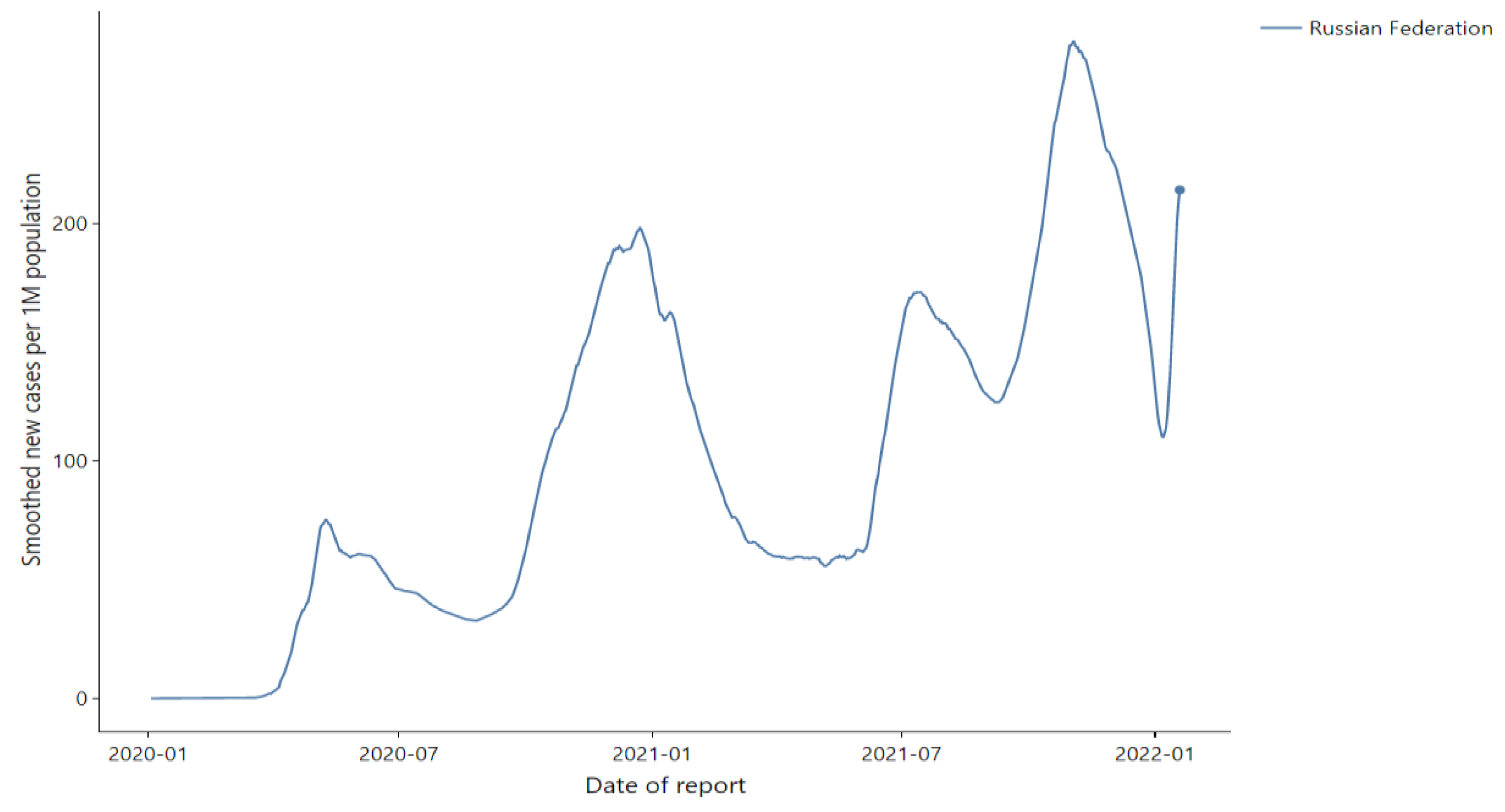
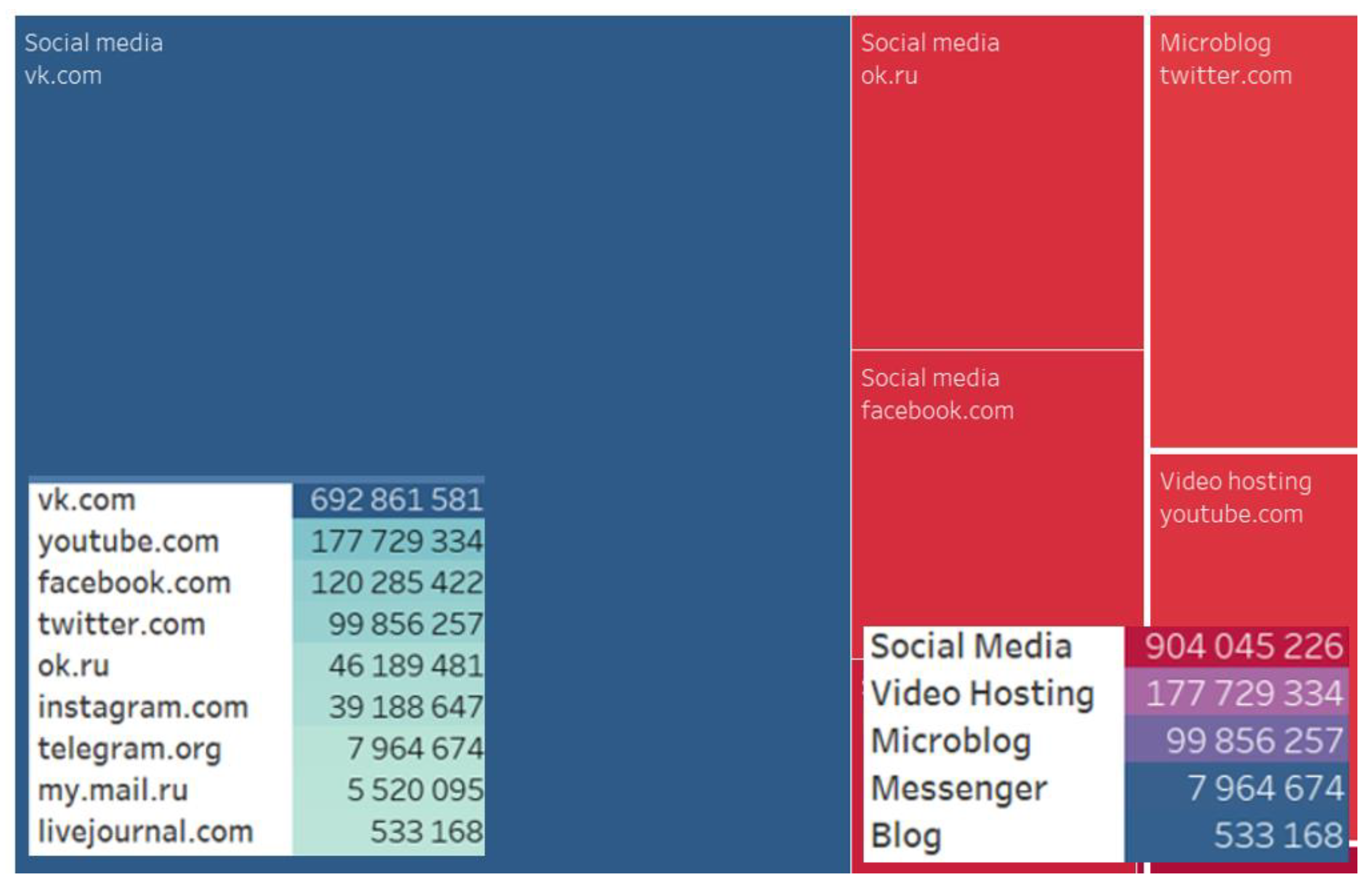
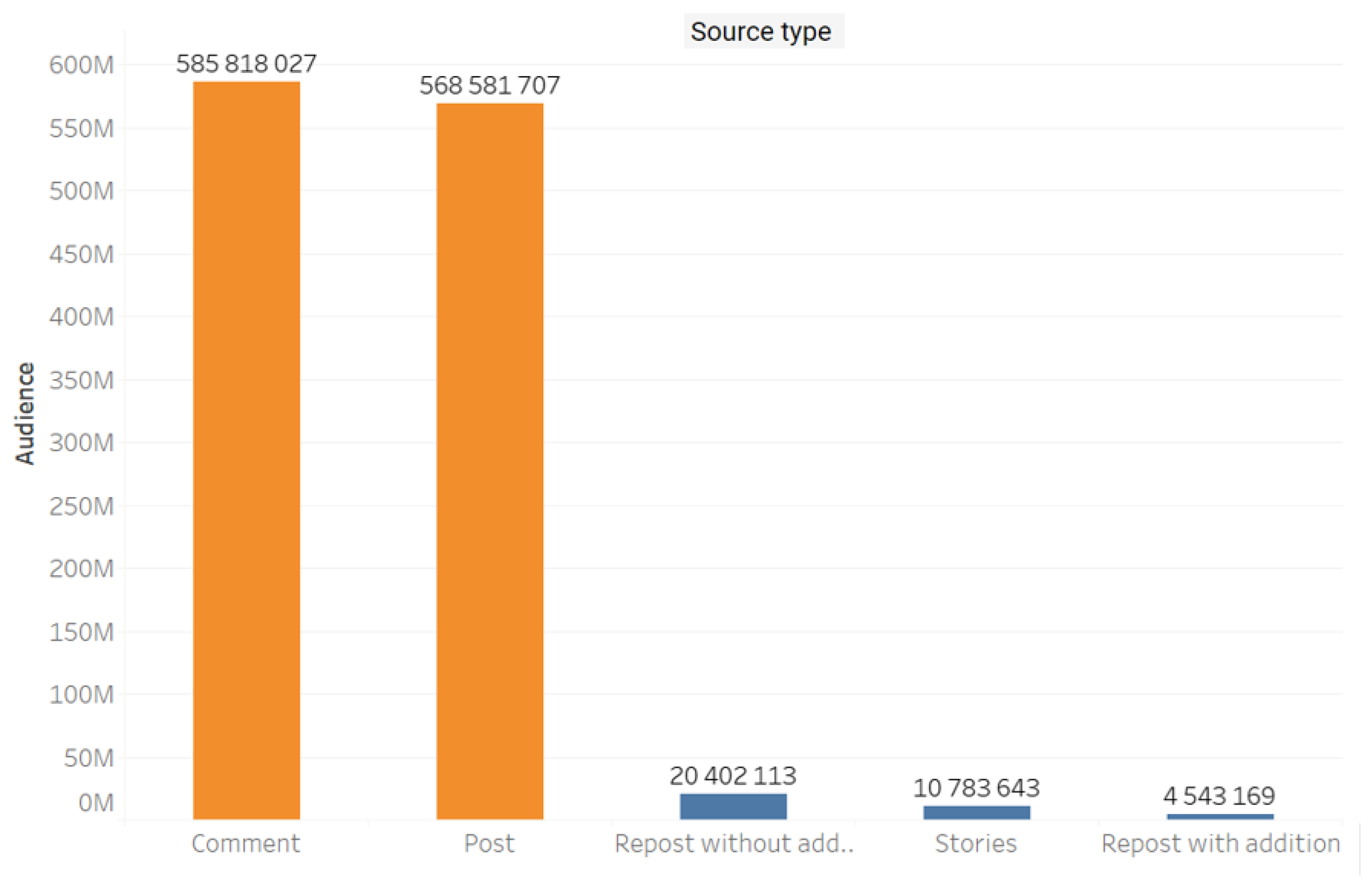
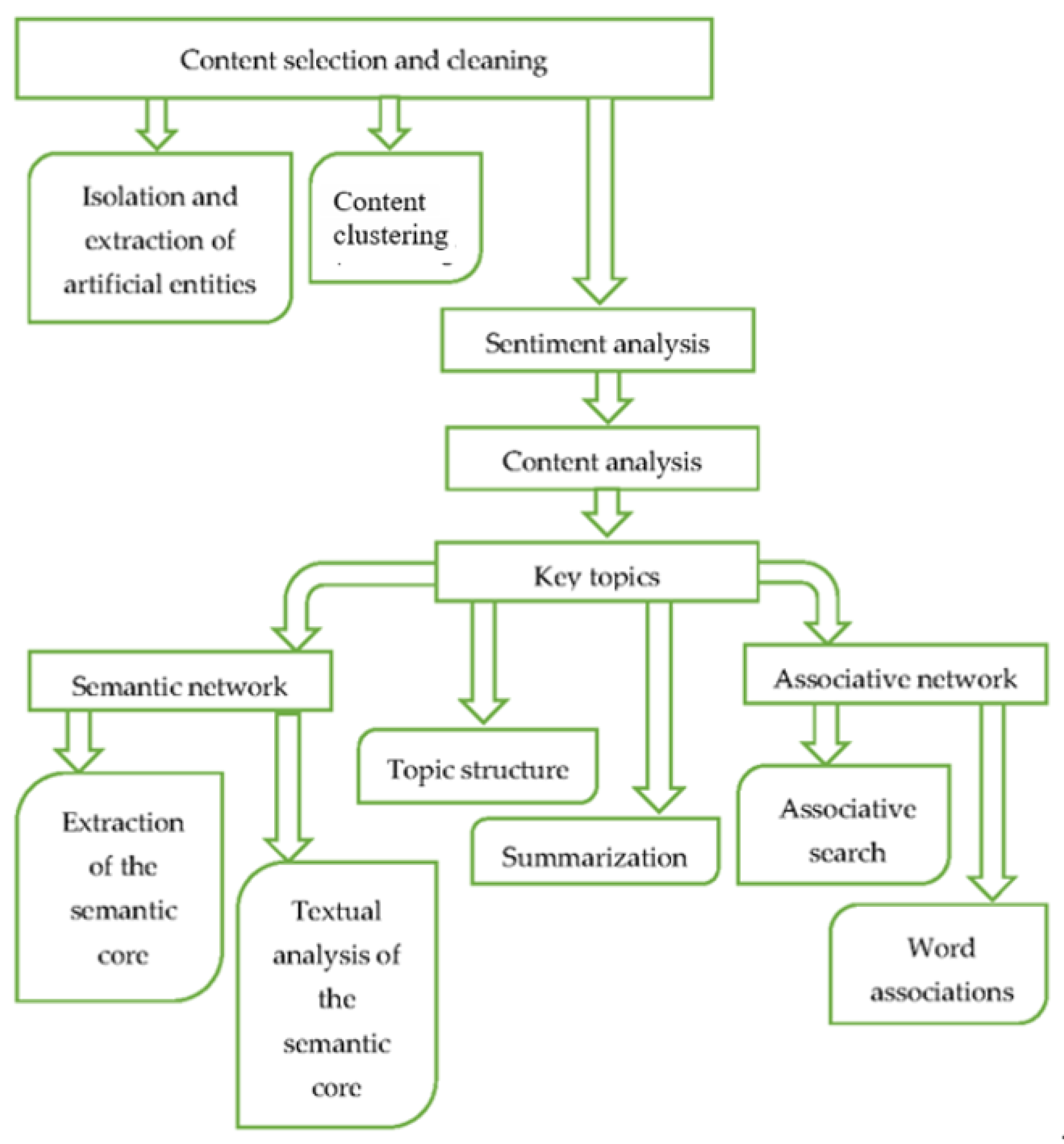
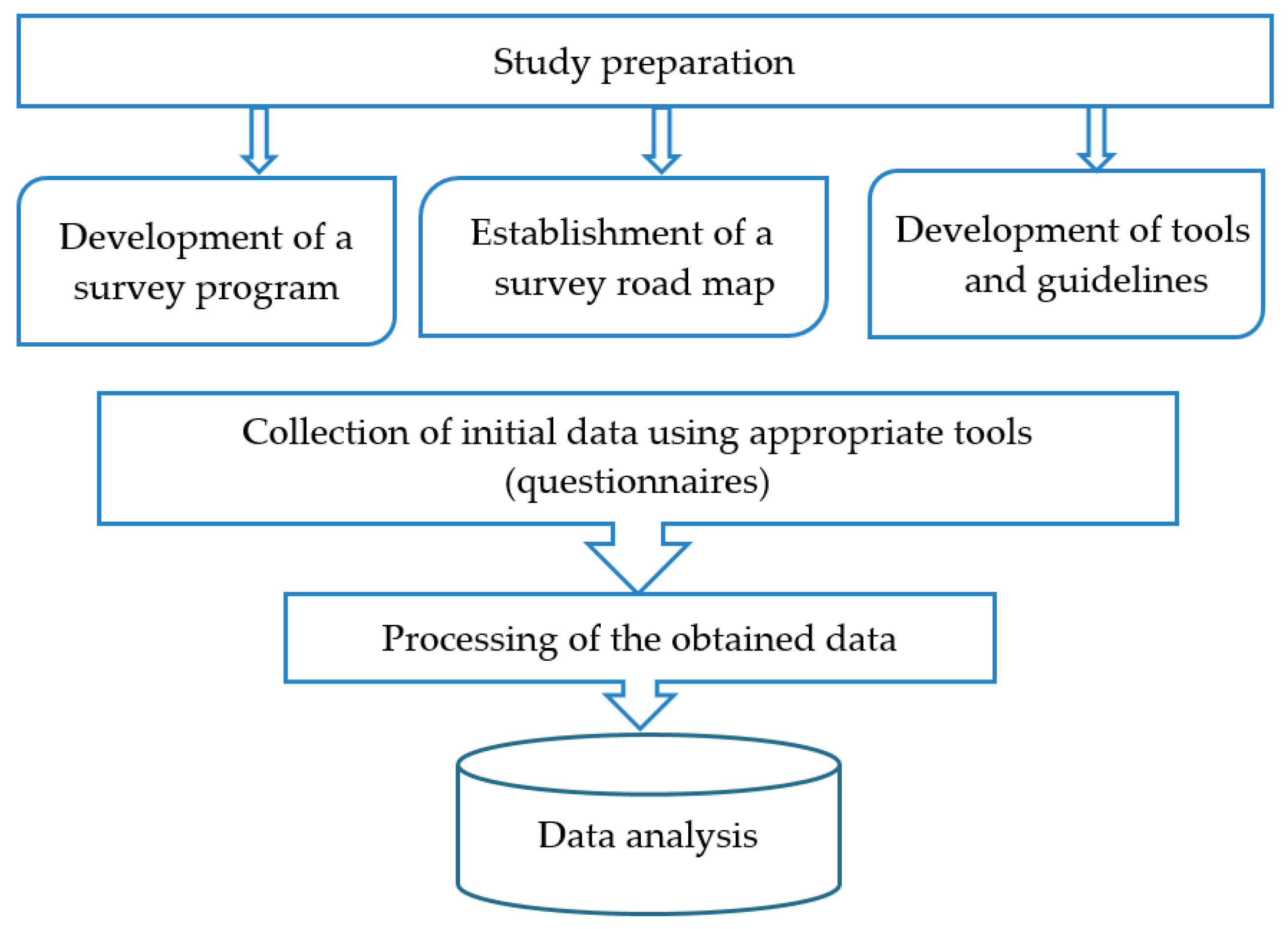
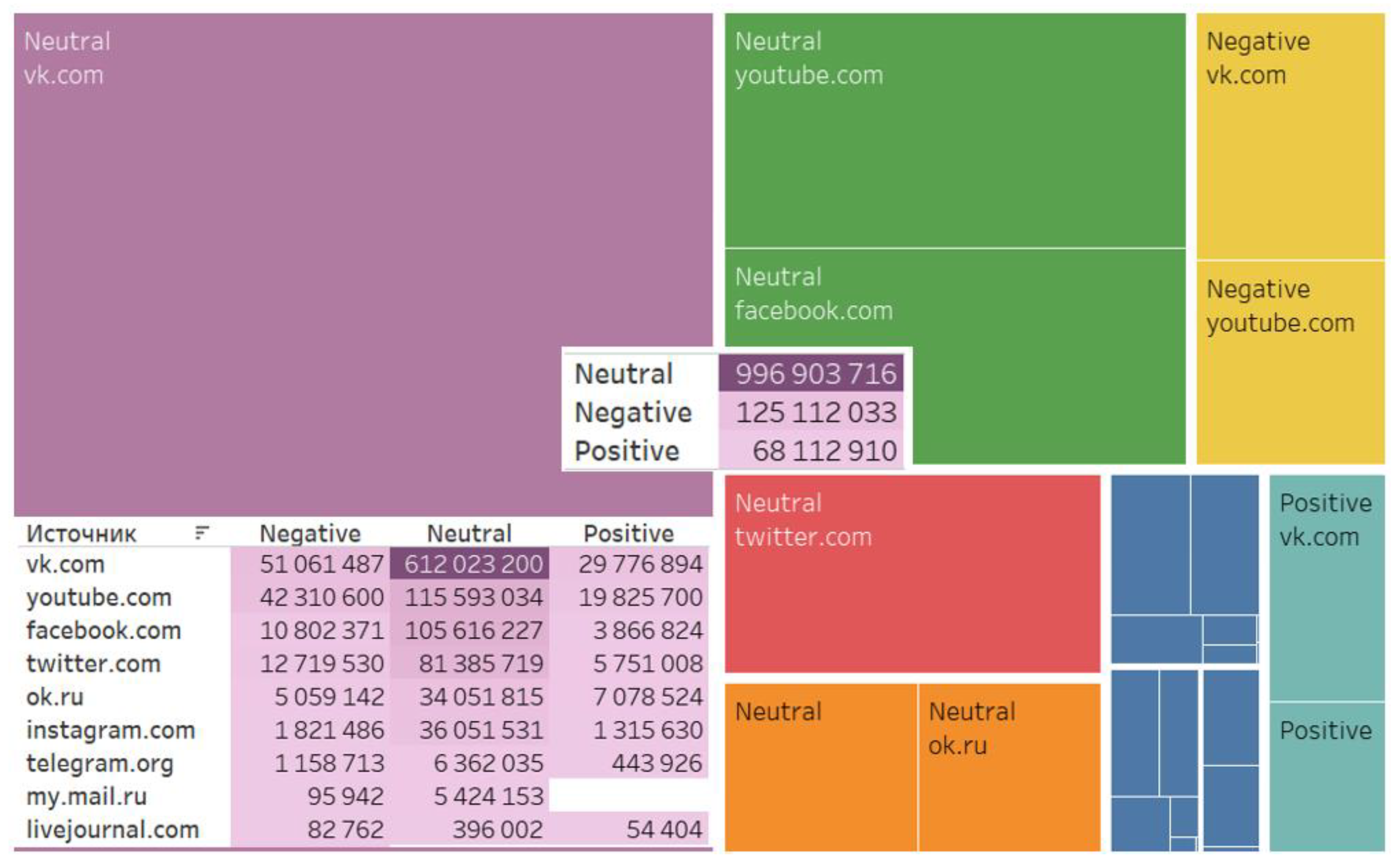
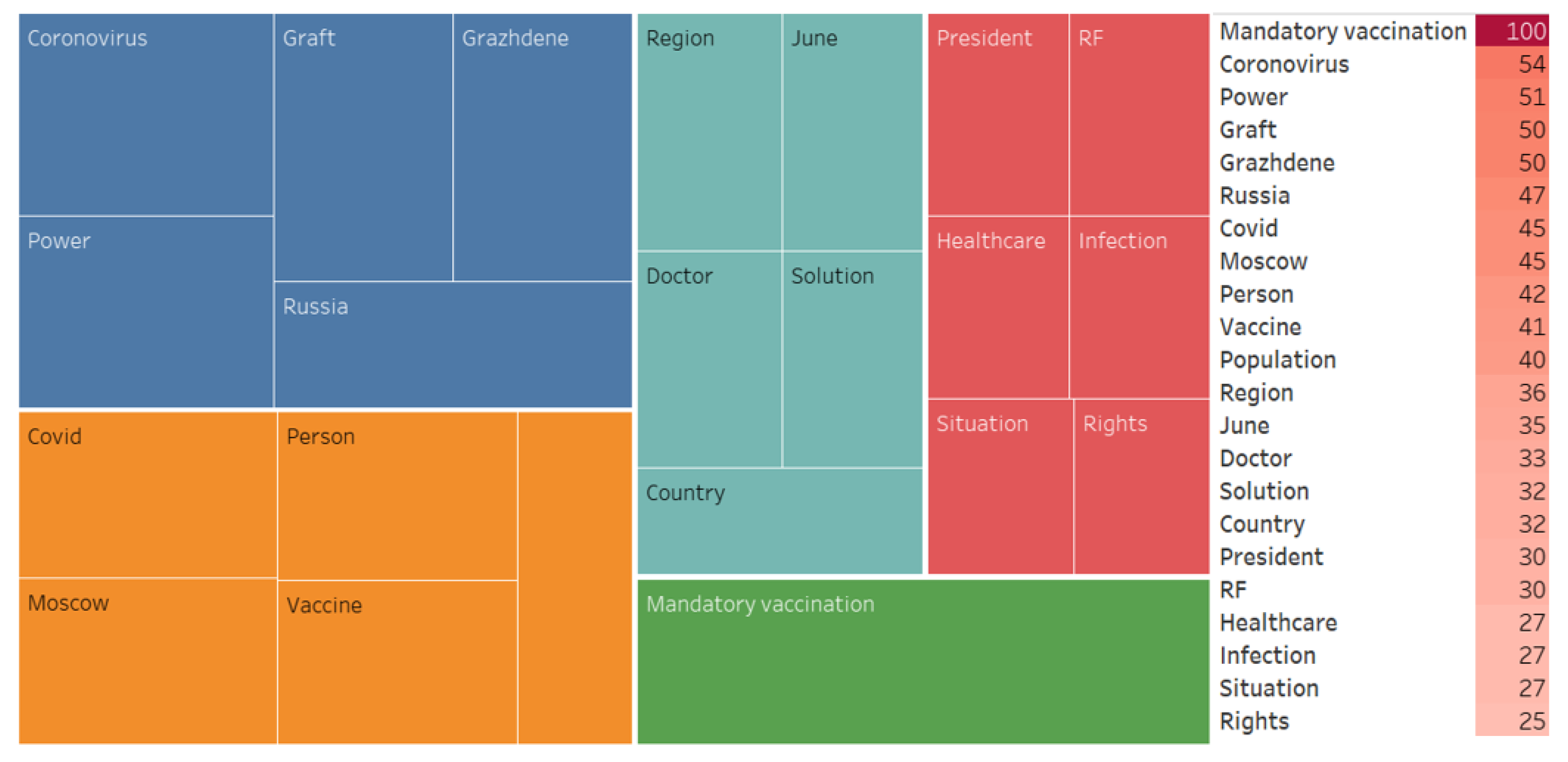
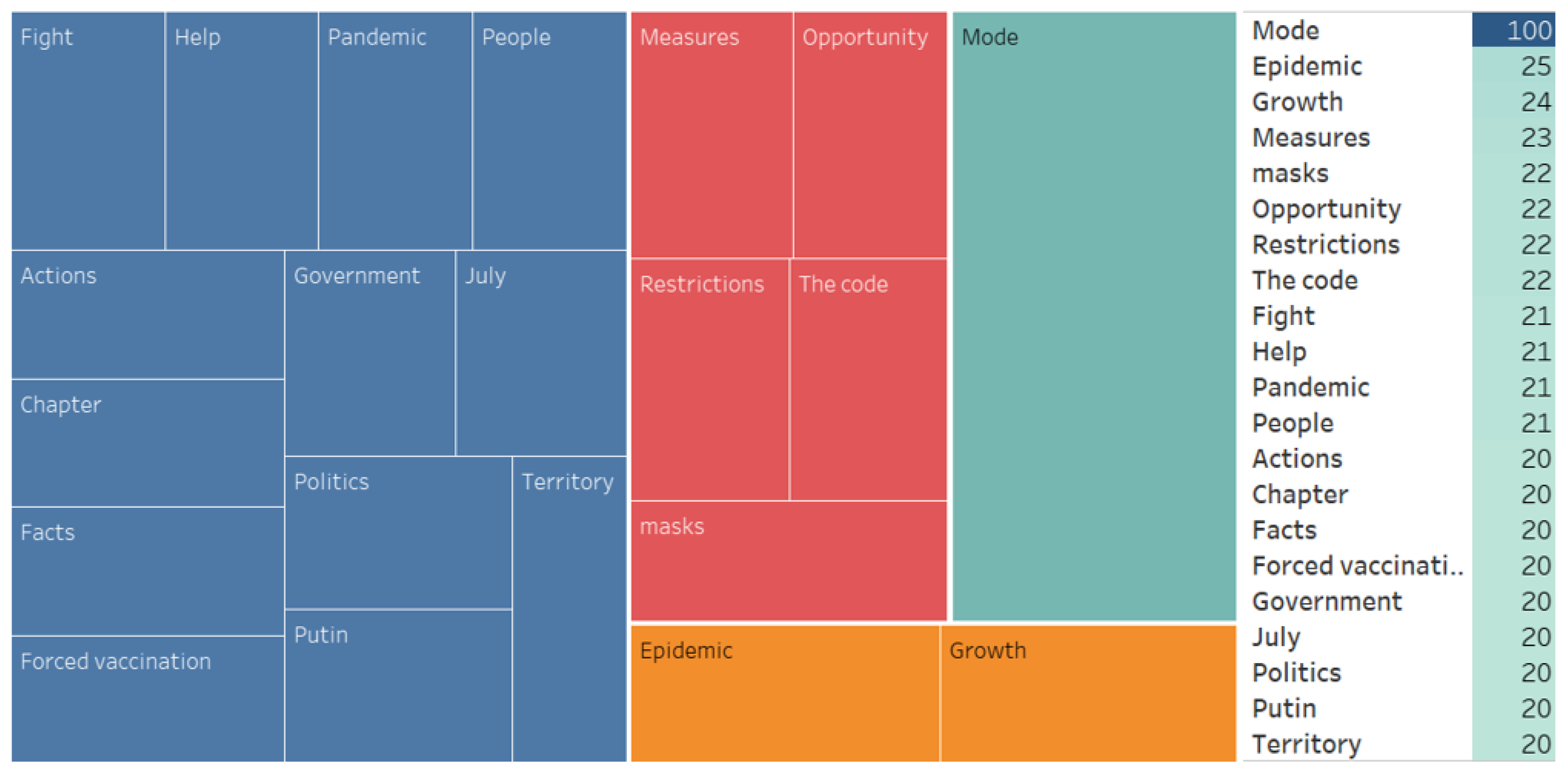
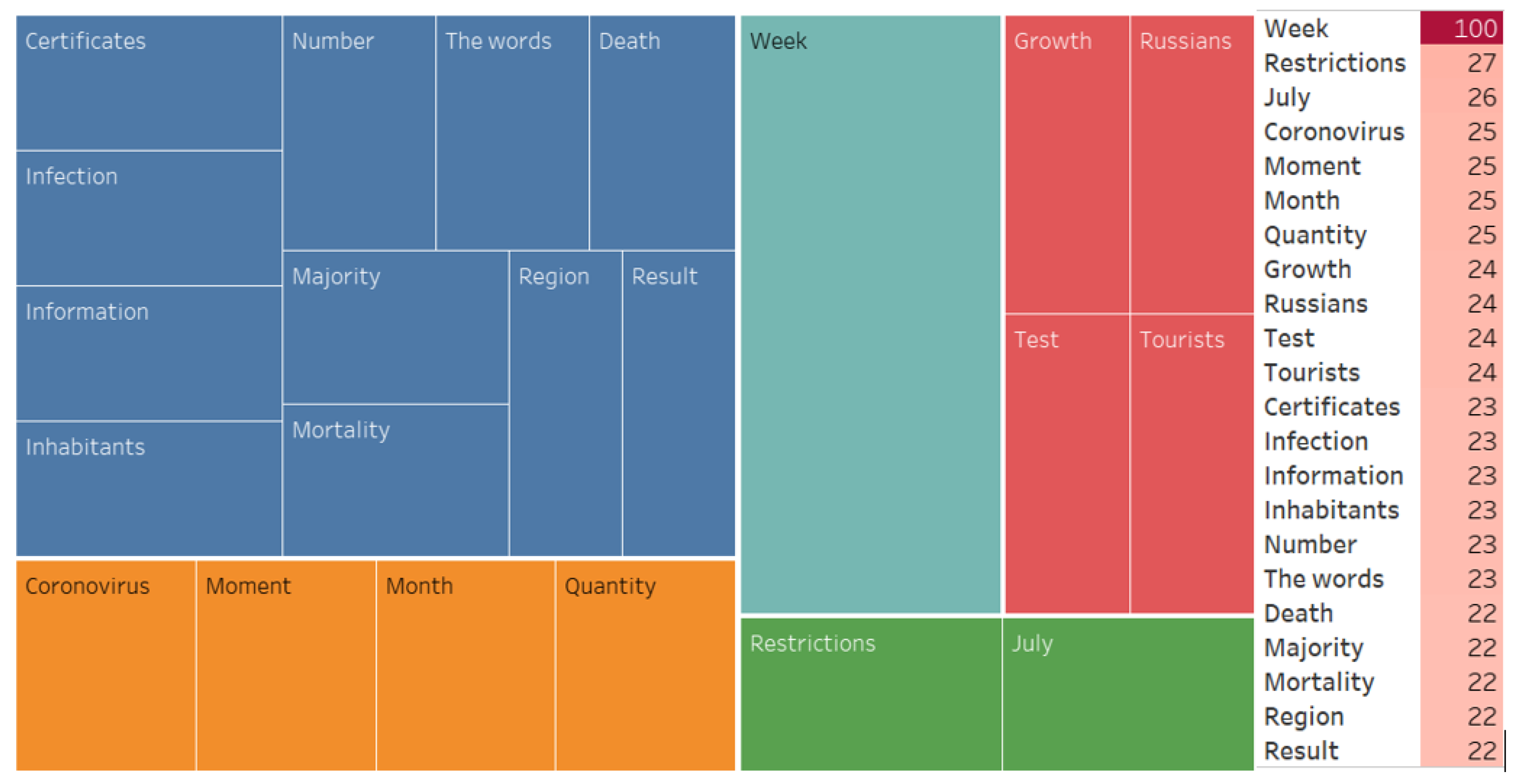
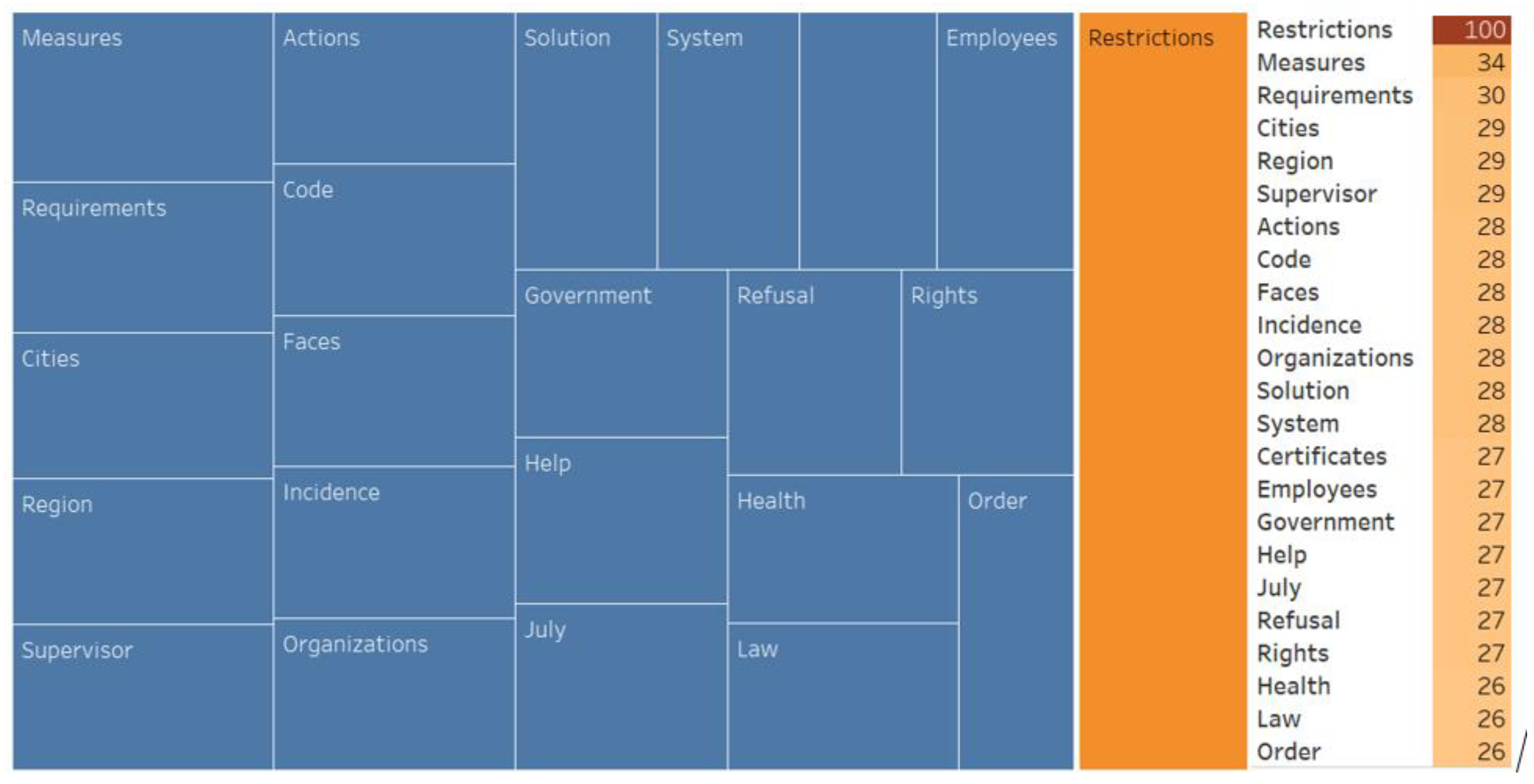

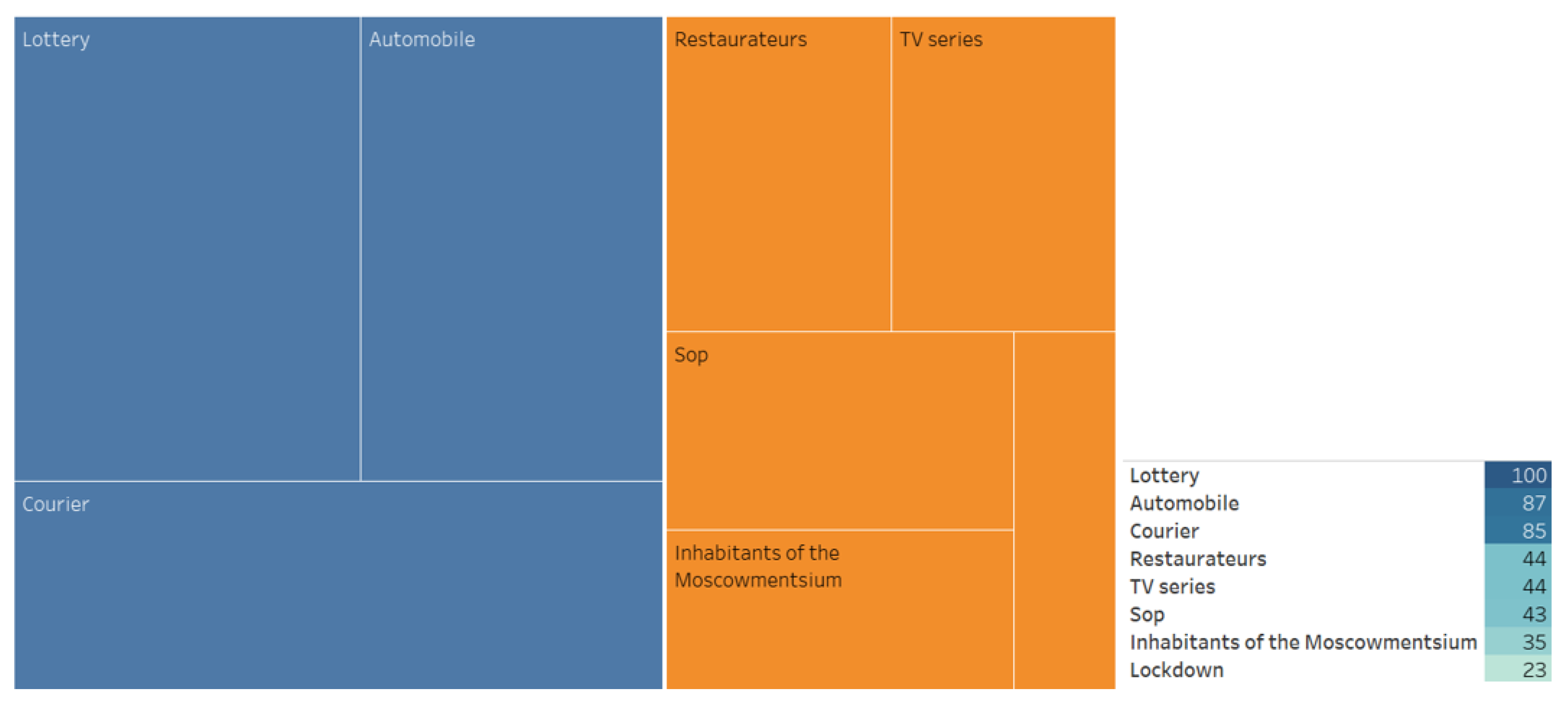

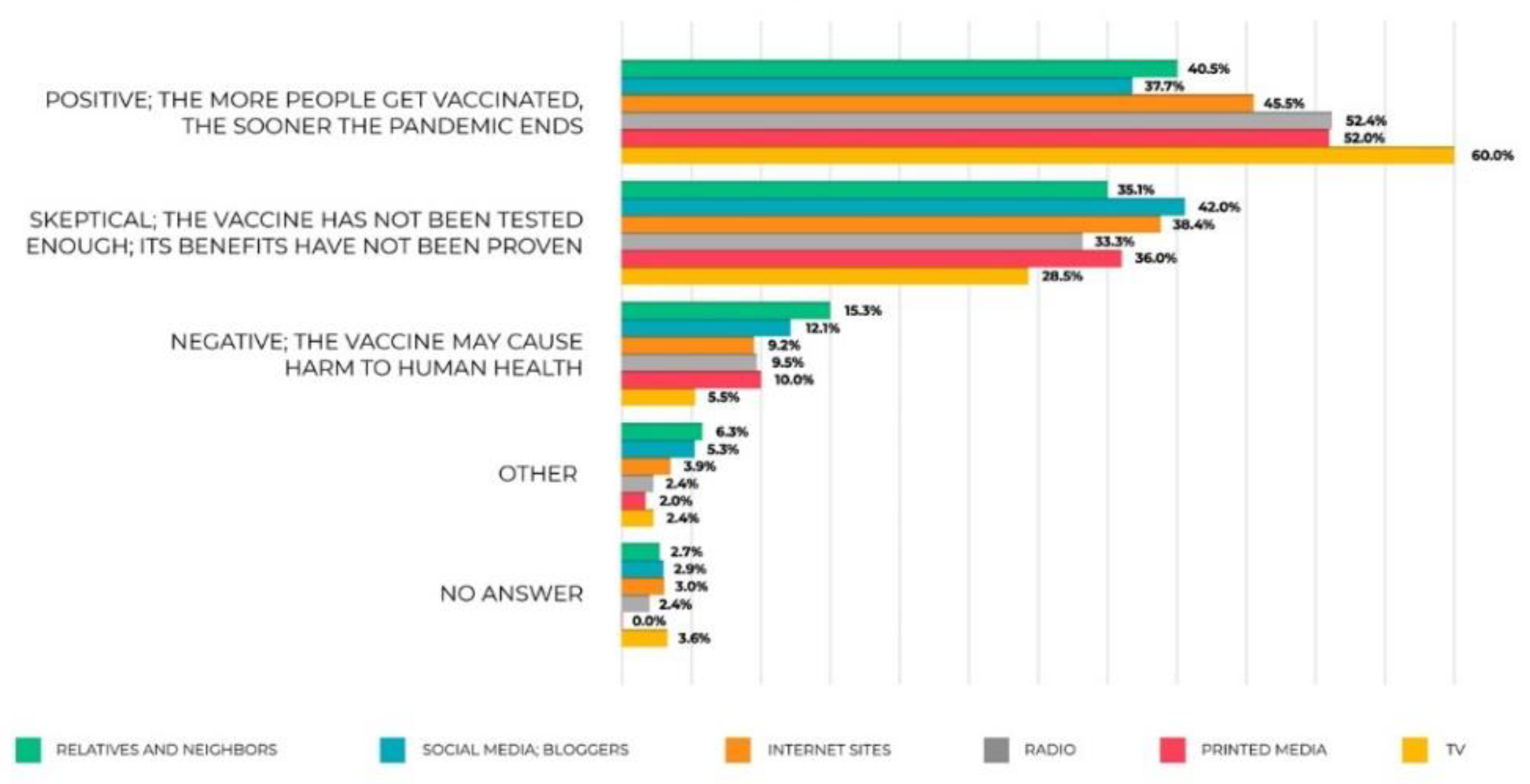

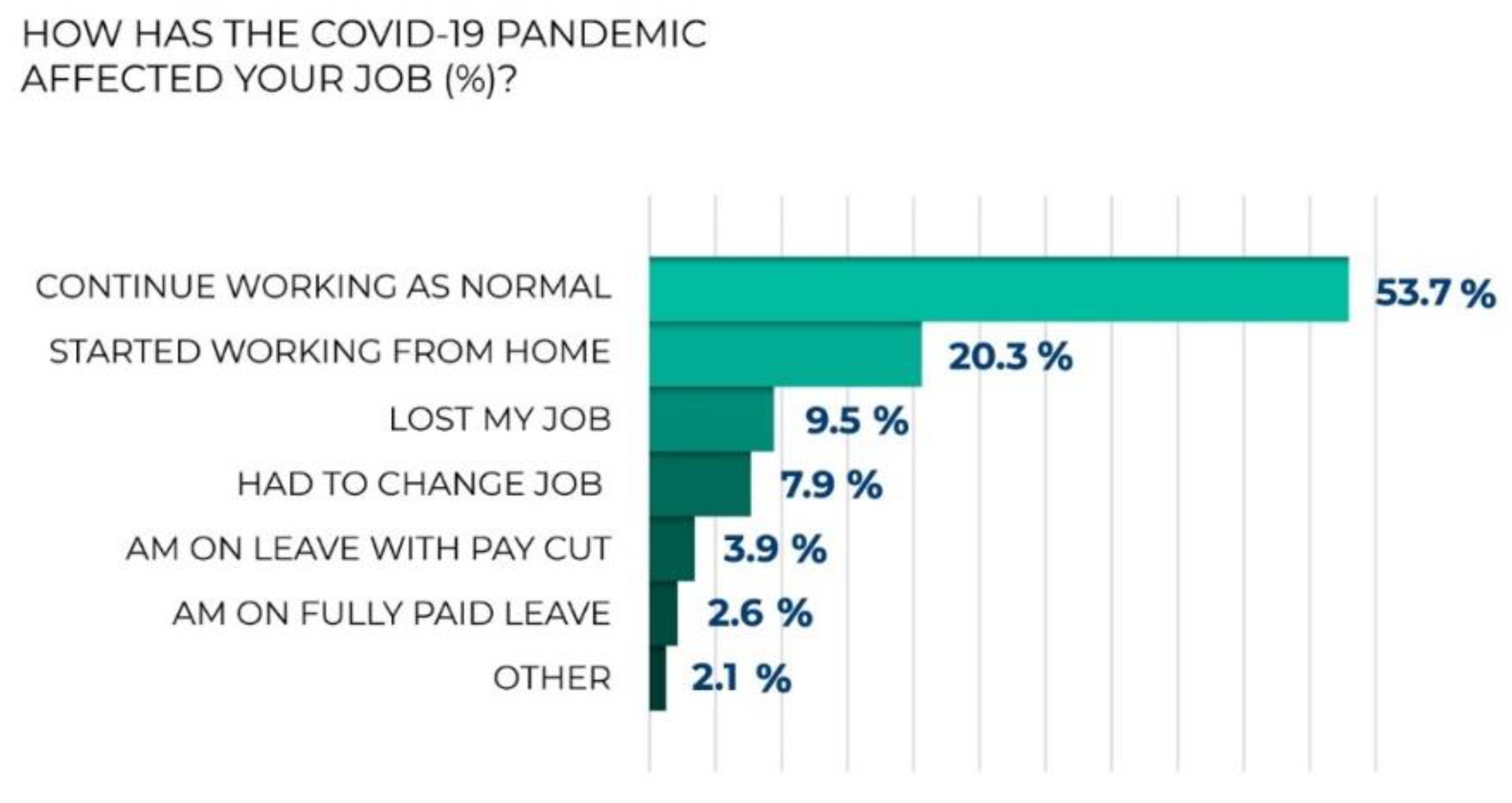
| Dataset | Authorities’ Actions |
|---|---|
| Non-Working Days | Declaration of 15 June 2021 to 19 June 2021 non-working days |
| Quarantine Restrictions | Closure of food courts and children’s playrooms in shopping malls, nighttime curfew for cafes and entertainment enterprises, restrictions in parks |
| Vaccination Prize Drawing | Drawing of cars for recently vaccinated citizens |
| Distance Learning for Universities | Transition to online learning for universities |
| Mandatory Vaccination | Mandatory vaccination for various groups of employees, temporary suspensions for non-vaccinated in several economic sectors |
| QR codes | COVID-19 free zones in cafes and restaurants, introduction of QR codes for visiting cafes, restaurants, theatres etc. |
Disclaimer/Publisher’s Note: The statements, opinions and data contained in all publications are solely those of the individual author(s) and contributor(s) and not of MDPI and/or the editor(s). MDPI and/or the editor(s) disclaim responsibility for any injury to people or property resulting from any ideas, methods, instructions or products referred to in the content. |
© 2023 by the authors. Licensee MDPI, Basel, Switzerland. This article is an open access article distributed under the terms and conditions of the Creative Commons Attribution (CC BY) license (https://creativecommons.org/licenses/by/4.0/).
Share and Cite
Raskhodchikov, A.N.; Pilgun, M. COVID-19 and Public Health: Analysis of Opinions in Social Media. Int. J. Environ. Res. Public Health 2023, 20, 971. https://doi.org/10.3390/ijerph20020971
Raskhodchikov AN, Pilgun M. COVID-19 and Public Health: Analysis of Opinions in Social Media. International Journal of Environmental Research and Public Health. 2023; 20(2):971. https://doi.org/10.3390/ijerph20020971
Chicago/Turabian StyleRaskhodchikov, Aleksey N., and Maria Pilgun. 2023. "COVID-19 and Public Health: Analysis of Opinions in Social Media" International Journal of Environmental Research and Public Health 20, no. 2: 971. https://doi.org/10.3390/ijerph20020971
APA StyleRaskhodchikov, A. N., & Pilgun, M. (2023). COVID-19 and Public Health: Analysis of Opinions in Social Media. International Journal of Environmental Research and Public Health, 20(2), 971. https://doi.org/10.3390/ijerph20020971







